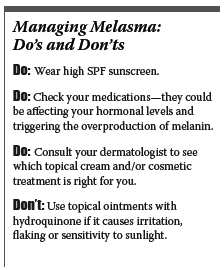Lighten up those skin discolorations for a visibly even visage
Hormones and sun exposure can take their toll on the face, causing patchy brown splotches and darkened areas. This lingering, uneven “tan” leaves many of us feeling self-conscious and wondering how we can get our skin back to an even and natural color.
When 31-year-old Emily began to notice dark patches under her eyes and just above her upper lip, she began to wonder why she seemed to have such an “unusual sun tan.”
“Basically, the places where the sun would really hit my face because of the way my face was angled, those were the places that I noticed it,” says this California resident. She adds that it gets worse when she’s in the sun. “I went skiing this winter one day and I noticed the next day it was more noticeable,” Emily says.
A Matter Of Melasma
The symmetrical markings, called melasma, result when melanocytes, the normal color-producing cells in the skin, make excess melanin causing a darkening or hyperpigmentation of the skin, explains Charles E. Crutchfield, III, MD, medical director of Crutchfield Dermatology in Eagan, Minn.
There is no single known cause of melasma, but there are several factors believed to contribute to its development, says Lisa Chipps, MD, a dermatologist at Moy-Fincher-Chipps Dermatology in Los Angeles who specializes in cosmetic dermatology and aesthetic surgery.
Melasma often occurs in women of child-bearing age and whenever there are hormonal changes. So it occurs frequently in those who are pregnant and who are taking birth control pills.
Common places that melasma appears are on the cheekbone area and on the upper lip, says Dr. Chipps, who is Emily’s dermatologist. And sun is definitely a factor, Dr. Chipps says. She explains that one of the keys to treating melasma is very good sun protection. Emily says she ramped up her SPF use, but was concerned that the melasma wasn’t going away and felt like it might even be getting worse.
Lighten Up!


Emily found that to be true in her case. So she opted instead for another topical that combined the power of hydroquinone 4% with tretinoin 0.05% and fluocinolone acetonide 0.01%. Tretinoin works to speed cell turnover in the skin, and fluocinolone acetonide is a low potency antiinflammatory cream that works to counteract the irritation caused by the hydroquinone. Kojic acid and azelaic acid are two other topical medications used to treat melasma.
Sometimes combining methods can yield better results. Chemical peels, microdermabrasion or laser therapy may also be used to bolster topical products. All of these treatments should be used in conjunction with a daily sunscreen, both Dr. Chipps and Dr. Crutchfield stress.
Even Expectations
The variety of treatment options makes down time and cost highly variable. Melasma is considered a cosmetic condition and is therefore not covered by insurance, Dr. Chipps notes. So depending on the patient’s budget, treatments could range from approximately $100 for a topical ointment or cream to several thousand dollars for certain laser treatments.
With topicals there is no down time. Even certain laser treatments will have you facing the world immediately following the procedure. With chemical peels, Dr. Chipps says your skin might be a little flaky for a couple of days, but there is no need to hide—and you can wear makeup.
Dr. Crutchfield says there is no treatment that works perfectly for all patients. “In my experience, topical medicines work 50 to 60 percent of the time and alpha-hydroxy acid treatments work approximately 70 percent of the time,” he says.
His advice is to be patient. “Nothing works perfectly, and even when you have something that works well, you have to make sure you protect yourself from the sun, so the melanocytes don’t produce melasma again,” he says.
Emily is committed to her Tri-Luma prescription and her sunscreen, even though she says that so far she hasn’t seen amazing results.


As frustrating as it is, she realizes consistent use and time are what will eventually make a difference. “I guess the cells have to renew and regenerate and it takes a while—it’s actually not just a surface thing it’s a cellular thing. So I have to use it very consistently for a couple of months for it to even make a difference,” she says.










